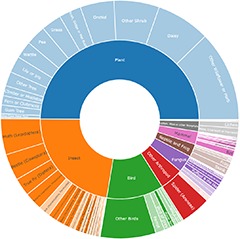Small Marsupials
PHOTOGRAPHY OF SMALL MAMMALS FOR IDENTIFICATION
Most photos of small terrestrial mammals submitted to Canberra Nature Map for identification that were photographed in the Canberra suburban area are of a Black Rat (Rattus rattus). The next most likely species is the House Mouse (Mus musculus). Outside the city, at present, photos of Black Rats outnumber all other small mammal photos combined. However you may have found something different. Here are some tips for what to include in your photos to increase the potential for correct identification:
- An image that is sharp, not blurry;
- A scale;
- A view of the whole animal (preferably stretched out if it is a carcass);
- Views of every surface - (not always possible but ideally this includes a profile of the head, good views of the ears, the belly, the pads on the hind feet, and a good view of the fur and skin on the tail from below and above);
- Views of the teeth; and
- A count of the number of teats.
Announcements
There are currently no announcements.
Discussion
VanessaC
wrote:
2 Nov 2025
Eastern barred bandicoot - I saw the stripes on its rump, but couldn't get a photo of it...
Perameles nasuta
Safarigirl
wrote:
4 Oct 2025
Thanks @DonFletcher
I’ll edit the video so it’s smaller and send it to you. It was eating moths drawn to the light from the lounge room. It was an amazing sight. I am unsure what other Antechinus or Dunnart species have been identified near here.
I’ll edit the video so it’s smaller and send it to you. It was eating moths drawn to the light from the lounge room. It was an amazing sight. I am unsure what other Antechinus or Dunnart species have been identified near here.
Antechinus flavipes
DonFletcher
wrote:
4 Oct 2025
Hi @Safarigirl, I can see it is a small Dasyurid, i.e. in this area an Antechinus or Sminthopsus (Dunnarts). Probably it was Antechinus agilis but I'd like more confidence in ruling out Sminthopsus murina and Antechinus flavipes. NatureMapper does not accept videos. Could you email a small video to me please at DonFletcher999@gmail.com Do you remember what Antechinus or Dunnart species have previously been identified in the vicinity?
Antechinus flavipes
Safarigirl
wrote:
3 Oct 2025
I have multiple video recordings and I’ve taken a screenshot but I’m unable to upload it
Antechinus flavipes
Significant sightings
- Bettongia penicillata
- Myrmecobius fasciatus
- Perameles nasuta at Uriarra Village, ACT
- Isoodon obesulus obesulus at Tharwa, ACT
- Peramelidae (family) at Cotter River, ACT
- Perameles nasuta at Cotter River, ACT
- Perameles nasuta at Booth, ACT
- Perameles nasuta at Booth, ACT
- Perameles nasuta at Booth, ACT
- Perameles nasuta at Booth, ACT
Top contributors
- MartinPredavec 103
- PEdwards 47
- jonvanbeest 47
- Gaia 30
- JoelStibbardBCT 27
- heatherb1997 23
- Frecko 20
- Topwood 18
- HelenCross 15
- Butlinz 13
Top moderators
- MartinPredavec 243
- JoelStibbardBCT 172
- DonFletcher 146
- Liam.m 144
- MichaelMulvaney 38
- Gaia 33
- JamesLidseyBCT 28
- MichaelBedingfield 24
- ChrisM 11
- Darcy 8













